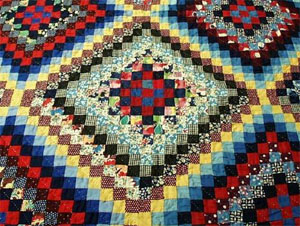Quilting Part IV: The Great Depression
See also: Quilting: Introduction; Quilting: 18th Century to Antebellum Era; Quilting: Civil War & Postwar Era; Quilting: 1880s to 1920s; Quilting: 20th Century & 1970s Revival; Quilting: 21st Century & Beyond
By the early 1930s, quiltmaking was surging. Print publications had begun broadly circulating quilt patterns, and fabric was more widely available than ever. No longer did quilting belong to the realm of the affluent. Quite inversely the craft had largely become one of subsistence and making do. North Carolina was a national leader in textile manufacturing, and mill ends, feed sacks, and other types of easily repurposed cloth were readily accessible. Feed companies even began using decoratively printed fabrics for their sacks to attract female consumers who would later turn the bags into garments and quilts.
One such thrifty consumer was Eliza Helen Rogers Arrington of Wake County. Her family members were proud to own their own cotton farm in an era when many—especially African American families like theirs—had to work other people’s land as tenant farmers or sharecroppers. She used sewing scraps as well as feed bags left over from caring for livestock to make both “everyday” and “special occasion” quilts. After Arrington finished a quilt, her daughters would play a game where they pointed out recognizable sewing scraps in the pattern, saying “that’s my dress, that’s your dress, that’s Mama’s dress, that’s the pig’s  sack.”
sack.”
For Lella Sneed of Franklin County, quiltmaking was purely a craft of necessity and survival. Employed as a cook and kitchen helper, Sneed was a busy woman who needed a warm quilt. She drew upon her resources to make one quickly, incorporating denim from worn-out overalls, and using every available scrap of cloth to piece together both the top and backing. She used large, uneven stitches, which attest to her haste and the difficulty of sewing bulky fabrics. Many North Carolinians r emember sleeping under stacks of such quilts in the wintertime, the multiple coverings weighing so heavily that it nearly proved impossible to roll over in bed. “Make-do” quilts like these and like Sneed’s saw heavy use and were less likely to be preserved or passed down to future generations than their decorative counterparts.
emember sleeping under stacks of such quilts in the wintertime, the multiple coverings weighing so heavily that it nearly proved impossible to roll over in bed. “Make-do” quilts like these and like Sneed’s saw heavy use and were less likely to be preserved or passed down to future generations than their decorative counterparts.
Some Depression-era quilters did invest the time to create showstoppers out of scrap fabric. Gaston County quilter Mamie Dameron made a “postage stamp” quilt in 1935. The piece is so named because none of its more than 11,000 pieces are larger than a postage stamp. During the 1930s–40s, competitive quilting became popular at local fairs and through magazine contests, and women endeavored to outdo each other in the number of patches they could piece into a single quilt.
Keep reading >>Quilting Part V: 20th Century & 1970s Revival![]()
References:
Abrahams, Ethel Ewert and Rachel K. Pannabecker. “‘Better Choose Me’: Addictions to Tobacco, Collecting, and Quilting, 1880–1920.” Uncoverings 21 (2000) : 79–105.
Baumgarten, Linda and Kimberly Smith Ivey. Four Centuries of Quilts: The Colonial Williamsburg Collection. New Haven: Yale University Press, 2014.
Brackman, Barbara, comp. Encyclopedia of Pieced Quilt Patterns. Paducah, KY: American Quilter’s Society, 1993.
Ducey, Carolyn. Chintz Appliqué: From Imitation to Icon. Lincoln, NE: International Quilt Study Center & Museum, 2008.
Jones, Lu Ann. Mama Learned Us to Work. Chapel Hill: University of North Carolina Press, 2002.
Kiracofe, Roderick. The American Quilt: A History of Cloth and Comfort 1750–1950. New York: Clarkson Potter, 1993.
McDonald, Mary Anne. “Symbols from Ribbons: Afro-American Funeral-Ribbon Quilts in Chatham County, North Carolina.” In Arts in Earnest: North Carolina Folklife, edited by Daniel W. Patterson and Charles G. Zugg, 164–178. Durham: Duke University Press, 1990.
Miller, Karin. Perils of the Birth Canal. June 1, 2014. From Quilt Alliance, Inspired By. Published in The Quilt Index, http://www.quiltindex.org/fulldisplay.php?kid=1-6-2EC. Accessed: 02/27/2015
Milspaw, Yvonne J. “Regional Style in Quilt Design.” The Journal of American Folklore 110, no. 438 (Autumn, 1997) : 363–390.
Orlofsky, Patsy and Myron. Quilts in America. New York: McGraw-Hill, 1974.
Roberson, Ruth Haislip, ed. North Carolina Quilts. Chapel Hill: University of North Carolina Press, 1988.
Roberts, Elise Schebler. The Quilt: A History and Celebration of an American Art Form. St. Paul: Voyageur Press, 2007.
Shaw, Robert. American Quilts: The Democratic Art. Updated Edition. New York: Sterling, 2014.
Image Credits:
All images from the collections of the North Carolina Museum of History. Used courtesy of the North Carolina Department of Cultural Resources.
5 March 2015 | Bell-Kite, Diana